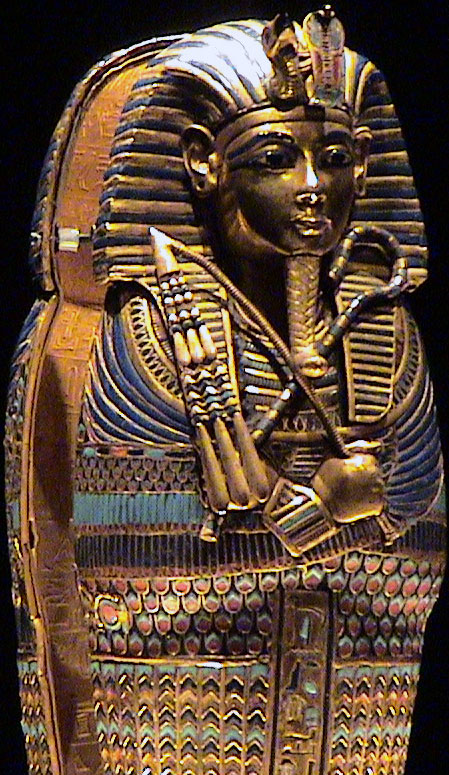 Egypt’s King Tut likely died from complications of a broken leg that was exacerbated by malaria, an extensive study of his mummy and family suggests.
Egypt’s King Tut likely died from complications of a broken leg that was exacerbated by malaria, an extensive study of his mummy and family suggests.
In Wednesday’s issue of the Journal of the American Medical Association, Zahi Hawass, of Cairo’s Supreme Council of Antiquities, and his colleagues published their findings based on DNA tests and CT scans of 16 mummies, including of Tutankhamun and his relatives.
The findings rounded out the family tree for Tut, who became a pharaoh at age 10 in 1333 BC, and ruled for nine years. After British archeologist Howard Carter discovered his tomb in 1922, Tut became known as the golden boy because of his golden tomb and the golden mask that covered his face.
Historians have suggested he was not a very powerful or important king, but the discovery of his virtually undisturbed tomb has made him world famous. Tut has been studied extensively by archeologists.
Historians had speculated he had been murdered in a power struggle, but a CT scan in 2005 ruled out foul play as the cause of his death.
The new study shows the pharaoh was weakened by congenital illnesses and succumbed to complications from a broken leg aggravated by severe malaria, based on the finding of DNA from a malaria parasite.
“A sudden leg fracture possibly introduced by a fall might have resulted in a life-threatening condition when a malaria infection occurred,” concluded the article in the Journal of the American Medical Association. “Tutankhamun had multiple disorders. He might be envisioned as a young but frail king who needed canes to walk.”
The research also disproved speculation that Tut and his relatives suffered from rare disorders that gave them feminine attributes and misshaped bones, such as Marfan syndrome, a connective tissue disorder that can result in elongated limbs.
The artistic style and statues of the period that showed royal men with prominent breasts, elongated heads and flared hips likely led to those theories.
“It is unlikely that either Tutankhamun or [his father] Akhenaten actually displayed a significantly bizarre or feminine physique,” the study’s authors said.
But they did confirm that the king may have had some form of inherited disease, a rare bone disorder affecting the foot called Kohler disease II, as well as a club foot and a curvature of the spine.
Although this was not his ultimate downfall, it would explain why among his possessions there were sticks and staves that could have been used as walking canes, say the researchers.
Not long before his death, the king fractured his leg, and the scientists think this was important.
Sponsored Content
In Wednesday’s issue of the Journal of the American Medical Association, Zahi Hawass, of Cairo’s Supreme Council of Antiquities, and his colleagues published their findings based on DNA tests and CT scans of 16 mummies, including of Tutankhamun and his relatives.
The findings rounded out the family tree for Tut, who became a pharaoh at age 10 in 1333 BC, and ruled for nine years. After British archeologist Howard Carter discovered his tomb in 1922, Tut became known as the golden boy because of his golden tomb and the golden mask that covered his face.
Historians have suggested he was not a very powerful or important king, but the discovery of his virtually undisturbed tomb has made him world famous. Tut has been studied extensively by archeologists.
Historians had speculated he had been murdered in a power struggle, but a CT scan in 2005 ruled out foul play as the cause of his death.
The new study shows the pharaoh was weakened by congenital illnesses and succumbed to complications from a broken leg aggravated by severe malaria, based on the finding of DNA from a malaria parasite.
“A sudden leg fracture possibly introduced by a fall might have resulted in a life-threatening condition when a malaria infection occurred,” concluded the article in the Journal of the American Medical Association. “Tutankhamun had multiple disorders. He might be envisioned as a young but frail king who needed canes to walk.”
The research also disproved speculation that Tut and his relatives suffered from rare disorders that gave them feminine attributes and misshaped bones, such as Marfan syndrome, a connective tissue disorder that can result in elongated limbs.
The artistic style and statues of the period that showed royal men with prominent breasts, elongated heads and flared hips likely led to those theories.
“It is unlikely that either Tutankhamun or [his father] Akhenaten actually displayed a significantly bizarre or feminine physique,” the study’s authors said.
But they did confirm that the king may have had some form of inherited disease, a rare bone disorder affecting the foot called Kohler disease II, as well as a club foot and a curvature of the spine.
Although this was not his ultimate downfall, it would explain why among his possessions there were sticks and staves that could have been used as walking canes, say the researchers.
Not long before his death, the king fractured his leg, and the scientists think this was important.
Sponsored Content